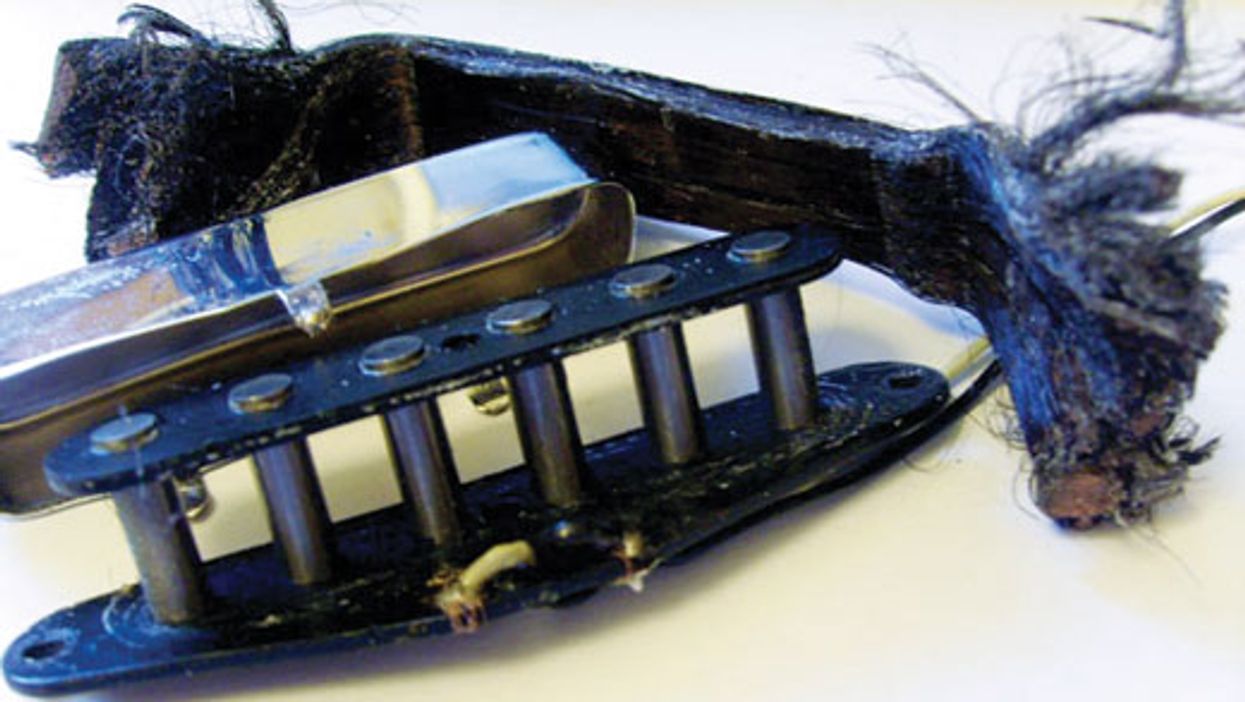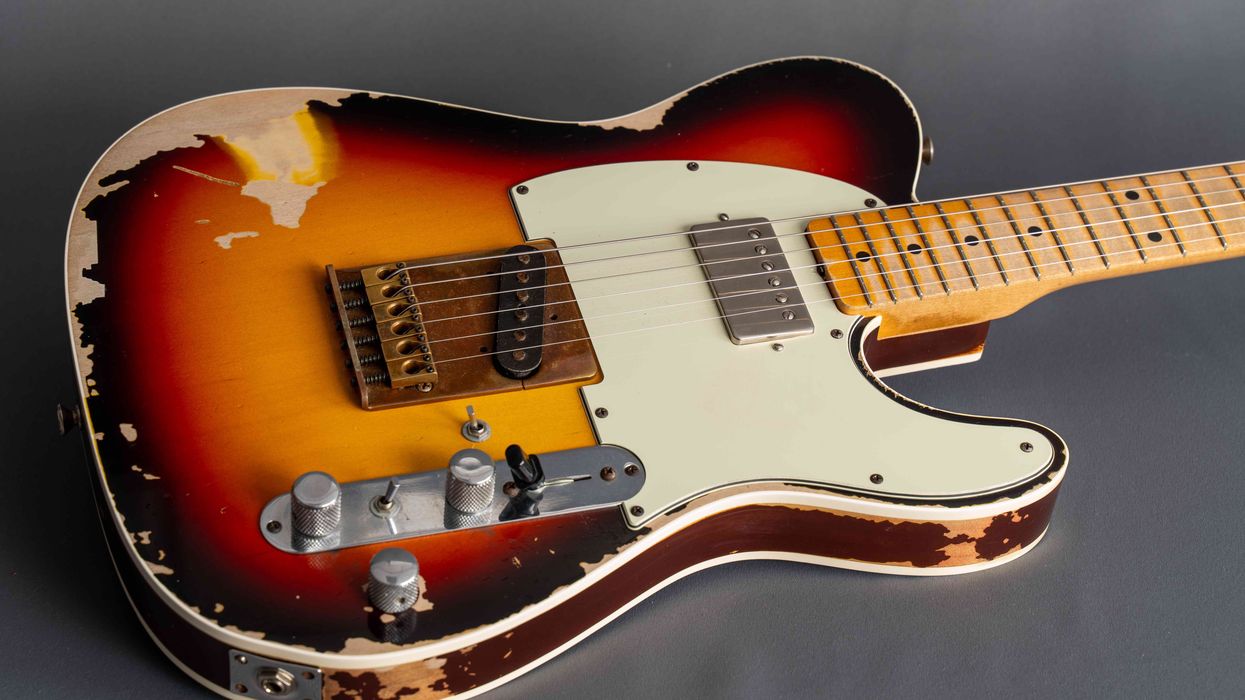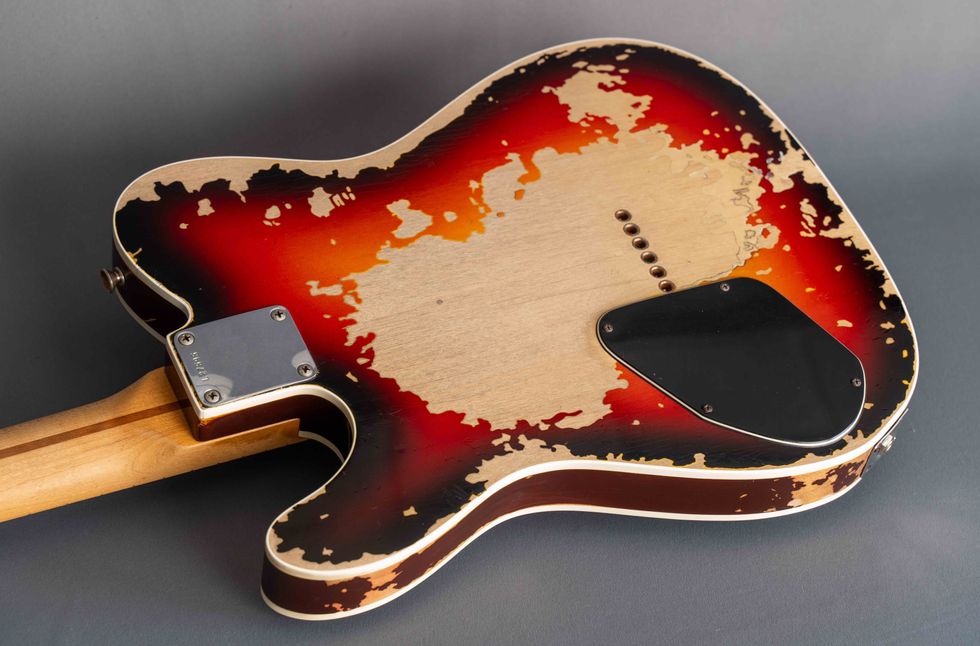Now that we've explored Telecaster bridge pickups, we've arrived at the final stage of our journey: the neck pickup. Smaller than a Stratocaster pickup, the stock Tele neck pickup sports a closed metal cover and is usually installed with two wood screws that tap right into the body underneath the pickguard.
Few players really love the Tele neck pickup. Why is this? I think it has to do with the remarkable sonic differences between the Tele's two pickups. The bridge pickup has a crystal-clear, loud, and twangy tone, while the neck pickup delivers less volume and has a kind of husky, colorless sound. When you switch from the bridge directly to the neck pickup, it sometimes feels as if something's wrong. Most players (myself included) don't like its sound and simply don't use it. But it's a shame to only use one pickup in a guitar that offers two!
Most of the muffled sound is caused by the metal cover, especially when it's not made of German silver (an alloy consisting of copper, nickel, and zinc), so it's always a good idea to remove the cover to enhance the pickup's tone. After removing the metal cover, if the coil wire is exposed you can protect it by wrapping it in some pickup tape. The cover is there to provide shielding, and if you don't want to lose this benefit, install an "open-frame" replacement metal cover. Essentially, this is a ring that protects the pickup, but leaves the top open. This helps the pickup's tone a lot, yet maintains most of the shielding.
If this doesn't do the trick for you, it's time to think about a replacement pickup. But remember, unless it's a drop-in Tele design, installing a replacement neck pickup requires enlarging the pickup cavity and either buying a new pickguard or reworking your current one. You'll also need to decide whether you want to stick with the traditional mounting method (screws surrounded by latex tubing going directly into the wood) or use a Strat-style method of drilling two holes through the pickguard. That said, there are some superb alternatives to the stock Tele neck pickup.
Stratocaster.
We all know the magic tone of a Stratocaster neck pickup. It's the perfect mate to a Telecaster bridge pickup, and even some Fender signature models like the Jerry Donahue and Clarence White Telecasters leave the factory with one. The benefits? You get a true Strat tone soloing the neck pickup, and it also sounds great combined with the Tele bridge pickup because the Strat pickup contributes warmth.
When you switch from the bridge directly to the neck pickup, it sometimes feels as if something's wrong.
P-90.
One of my personal choices is a P-90 soapbar pickup, but you can also use a P-94 in standard humbucker size. A P-90 looks great on a Telecaster, and its fat single-coil tone is very versatile. An outstanding combination is an Esquire/Nocaster/Broadcaster-style bridge pickup plus a P-90 at the neck. Both sounds fit together perfectly, and when you use 4-way switching wiring with both pickups in series rather than parallel, you can make every tube amp sing.
Mini-humbucker/Firebird.
This is another great choice with a tone that's similar to a P-90, but a tad fatter and warmer—and naturally free of hum and noise because these are real humbuckers! The enclosed Firebird pickup offers a bit more high end compared to the mini-humbucker with its open pole-piece row. Nashville session giant Brent Mason orients his neck-position mini-humbucker so the open pole-piece row faces the bridge. Compared to the standard installation, this gives the pickup a little more treble bite. Sonically, this pickup type falls between a P-90 single-coil and a full PAF-style humbucker.
PAF-style humbucker.
Ah—the classic Keith Richards configuration. A full-sized humbucker delivers a Les Paul-inspired neck pickup tone, but because of the Telecaster's longer scale length, you get a stronger attack and more note definition. Surprisingly, the sound of a vintage-flavored PAF humbucker works well with a Tele bridge pickup, and playing them together wired in parallel results in a well-balanced tone in the P-90 ballpark.
Lipstick.
With its glassy, twangy tone, the lipstick pickup is a perfect choice for funk, ska, surf, or reggae players. I recommend pairing it with a warmer-sounding bridge pickup—a Nocaster-type or something in the overwound/Texas Special ballpark. A lipstick is also ideal if you want to imitate flattop strumming on your Tele: Roll back the volume to about 60 or 70 percent and make sure you're not using a treble-bleed network on the volume pot. Configured this way, a lipstick neck pickup sounds quite "acoustic."
Charlie Christian.
This design sounds marvelous on a Tele in the neck position, and not only for jazz, swing, and bebop. In addition to the original Gibson version with its metal frame, some companies offer CC pickups in a standard humbucker shape, so putting one in your Tele is much easier than it was years ago. This pickup sounds fat and mellow, but always defined with clear top end and tons of sustain.
DeArmond/Filter'Tron.
A great choice for classic rock 'n' roll, surf, and of course, rockabilly. Bright, warm, and twangy, the Gretsch-inspired pickup is a perfect mate for all Nocaster-style bridge pickups. Many rockabilly players prefer a Bigsby-equipped Tele with this pickup combination instead of a feedback-prone semi-hollow guitar. It's a fine way to get old-school tone.
Next time we'll put our Teles out of phase, and I'll share a funny historic story on this topic. Until then, keep on modding!
[Updated 7/27/21]






































